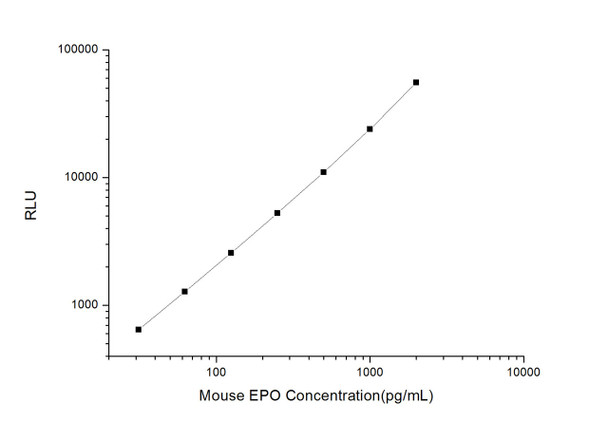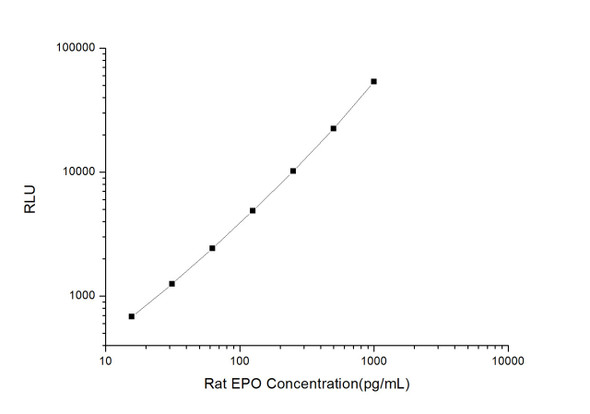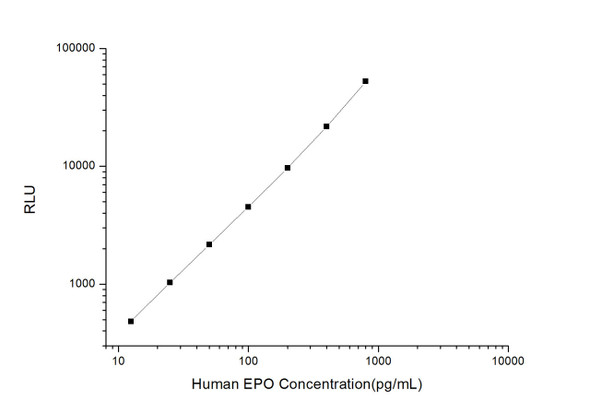Mouse Immunology ELISA Kits
Mouse EPO (Erythropoietin) CLIA Kit (MOES00024)
- SKU:
- MOES00024
- Product Type:
- ELISA Kit
- ELISA Type:
- CLIA Kit
- Size:
- 96 Assays
- Sensitivity:
- 18.75pg/mL
- Range:
- 31.25-2000pg/mL
- ELISA Type:
- Sandwich
- Synonyms:
- EP, MVCD2, Epoetin, Hematopoietin, Hemopoietin
- Reactivity:
- Mouse
- Sample Type:
- Serum, plasma and other biological fluids
- Research Area:
- Immunology
Description
| Assay type: | Sandwich |
| Format: | 96T |
| Assay time: | 4.5h |
| Reactivity: | Mouse |
| Detection method: | Chemiluminescence |
| Detection range: | 31.25-2000 pg/mL |
| Sensitivity: | 18.75 pg/mL |
| Sample volume: | 100µL |
| Sample type: | Serum, plasma and other biological fluids |
| Repeatability: | CV < 15% |
| Specificity: | This kit recognizes Mouse EPO in samples. No significant cross-reactivity or interference between Mouse EPO and analogues was observed. |
This kit uses Sandwich-CLIA as the method. The micro CLIA plate provided in this kit has been pre-coated with an antibody specific to Mouse EPO. Standards or samples are added to the appropriate micro CLIA plate wells and combined with the specific antibody. Then a biotinylated detection antibody specific for Mouse EPO and Avidin-Horseradish Peroxidase (HRP) conjugate are added to each micro plate well successively and incubated. Free components are washed away. The substrate solution is added to each well. Only those wells that contain Mouse EPO, biotinylated detection antibody and Avidin-HRP conjugate will appear fluorescence. The Relative light unit (RLU) value is measured spectrophotometrically by the Chemiluminescence immunoassay analyzer. The RLU value is positively associated with the concentration of Mouse EPO. The concentration of Mouse EPO in the samples can be calculated by comparing the RLU of the samples to the standard curve.
| UniProt Protein Function: | EPO: Erythropoietin is the principal hormone involved in the regulation of erythrocyte differentiation and the maintenance of a physiological level of circulating erythrocyte mass. Genetic variation in EPO is associated with susceptbility to microvascular complications of diabetes type 2 (MVCD2). These are pathological conditions that develop in numerous tissues and organs as a consequence of diabetes mellitus. They include diabetic retinopathy, diabetic nephropathy leading to end-stage renal disease, and diabetic neuropathy. Diabetic retinopathy remains the major cause of new-onset blindness among diabetic adults. It is characterized by vascular permeability and increased tissue ischemia and angiogenesis. Belongs to the EPO/TPO family. |
| UniProt Protein Details: | Protein type:Secreted; Secreted, signal peptide Cellular Component: extracellular space; cell surface; extracellular region Molecular Function:erythropoietin receptor binding; hormone activity; protein kinase activator activity Biological Process: hemoglobin biosynthetic process; heart morphogenesis; erythrocyte maturation; apoptosis; positive regulation of transcription, DNA-dependent; regulation of transcription from RNA polymerase II promoter; negative regulation of myeloid cell apoptosis; peptidyl-serine phosphorylation; positive regulation of tyrosine phosphorylation of Stat5 protein; positive regulation of protein kinase activity; positive regulation of cell proliferation; cardiac muscle morphogensis; response to hypoxia; erythrocyte differentiation; ventricular cardiac muscle morphogenesis; angiogenesis; positive regulation of Ras protein signal transduction; positive regulation of neuron differentiation; embryo implantation; positive regulation of DNA replication; negative regulation of apoptosis |
| NCBI Summary: | This gene encodes the glycoprotein hormone erythropoietin that regulates the production of red blood cells and biosynthesis of hemoglobin. The predominant expression of this gene shifts from the liver during fetal development to kidney in adults. A complete lack of the encoded protein causes embryonic lethal anemia in mice. The conditional inactivation of this gene in adult mice results in a chronic, normocytic and normochromic anemia. Transgenic mice expressing the human ortholog of this gene exhibit polycythemia. Alternative splicing results in multiple transcript variants encoding different isoforms. [provided by RefSeq, Aug 2015] |
| UniProt Code: | P07321 |
| NCBI GenInfo Identifier: | 119528 |
| NCBI Gene ID: | 13856 |
| NCBI Accession: | P07321. 1 |
| UniProt Related Accession: | P07321 |
| Molecular Weight: | |
| NCBI Full Name: | Erythropoietin |
| NCBI Synonym Full Names: | erythropoietin |
| NCBI Official Symbol: | Epo |
| NCBI Protein Information: | erythropoietin |
| UniProt Protein Name: | Erythropoietin |
| Protein Family: | Erythropoietin |
| UniProt Gene Name: | Epo |
| UniProt Entry Name: | EPO_MOUSE |
As the RLU values of the standard curve may vary according to the conditions of the actual assay performance (e. g. operator, pipetting technique, washing technique or temperature effects), the operator should establish a standard curve for each test. Typical standard curve and data is provided below for reference only.
| Concentration (pg/mL) | RLU | Average | Corrected |
| 2000 | 53497 57945 | 55721 | 55693 |
| 1000 | 22722 25226 | 23974 | 23946 |
| 500 | 11418 10646 | 11032 | 11004 |
| 250 | 5135 5453 | 5294 | 5266 |
| 125 | 2761 2455 | 2608 | 2580 |
| 62.5 | 1359 1263 | 1311 | 1283 |
| 31.25 | 635 713 | 674 | 646 |
| 0 | 27 29 | 28 | -- |
Precision
Intra-assay Precision (Precision within an assay): 3 samples with low, mid range and high level Mouse EPO were tested 20 times on one plate, respectively.
Inter-assay Precision (Precision between assays): 3 samples with low, mid range and high level Mouse EPO were tested on 3 different plates, 20 replicates in each plate.
| Intra-assay Precision | Inter-assay Precision | |||||
| Sample | 1 | 2 | 3 | 1 | 2 | 3 |
| n | 20 | 20 | 20 | 20 | 20 | 20 |
| Mean (pg/mL) | 96.44 | 252.27 | 855.93 | 95.13 | 236.80 | 937.10 |
| Standard deviation | 11.39 | 23.46 | 85.51 | 9.17 | 18.45 | 90.90 |
| C V (%) | 11.81 | 9.30 | 9.99 | 9.64 | 7.79 | 9.70 |
Recovery
The recovery of Mouse EPO spiked at three different levels in samples throughout the range of the assay was evaluated in various matrices.
| Sample Type | Range (%) | Average Recovery (%) |
| Serum (n=5) | 83-95 | 90 |
| EDTA plasma (n=5) | 91-107 | 98 |
| Cell culture media (n=5) | 94-107 | 99 |
Linearity
Samples were spiked with high concentrations of Mouse EPO and diluted with Reference Standard & Sample Diluent to produce samples with values within the range of the assay.
| Serum (n=5) | EDTA plasma (n=5) | Cell culture media (n=5) | ||
| 1:2 | Range (%) | 91-108 | 91-106 | 95-109 |
| Average (%) | 99 | 97 | 100 | |
| 1:4 | Range (%) | 95-109 | 91-107 | 93-104 |
| Average (%) | 102 | 99 | 99 | |
| 1:8 | Range (%) | 100-113 | 89-102 | 86-99 |
| Average (%) | 105 | 94 | 93 | |
| 1:16 | Range (%) | 95-108 | 96-110 | 96-109 |
| Average (%) | 102 | 102 | 103 |
An unopened kit can be stored at 4°C for 1 month. If the kit is not used within 1 month, store the items separately according to the following conditions once the kit is received.
| Item | Specifications | Storage |
| Micro CLIA Plate(Dismountable) | 8 wells ×12 strips | -20°C, 6 months |
| Reference Standard | 2 vials | |
| Concentrated Biotinylated Detection Ab (100×) | 1 vial, 120 µL | |
| Concentrated HRP Conjugate (100×) | 1 vial, 120 µL | -20°C(shading light), 6 months |
| Reference Standard & Sample Diluent | 1 vial, 20 mL | 4°C, 6 months |
| Biotinylated Detection Ab Diluent | 1 vial, 14 mL | |
| HRP Conjugate Diluent | 1 vial, 14 mL | |
| Concentrated Wash Buffer (25×) | 1 vial, 30 mL | |
| Substrate Reagent A | 1 vial, 5 mL | 4°C (shading light) |
| Substrate Reagent B | 1 vial, 5 mL | 4°C (shading light) |
| Plate Sealer | 5 pieces | |
| Product Description | 1 copy | |
| Certificate of Analysis | 1 copy |
- Set standard, test sample and control (zero) wells on the pre-coated plate and record theirpositions. It is recommended to measure each standard and sample in duplicate. Note: addall solutions to the bottom of the plate wells while avoiding contact with the well walls. Ensuresolutions do not foam when adding to the wells.
- Aliquot 100µl of standard solutions into the standard wells.
- Add 100µl of Sample / Standard dilution buffer into the control (zero) well.
- Add 100µl of properly diluted sample (serum, plasma, tissue homogenates and otherbiological fluids. ) into test sample wells.
- Cover the plate with the sealer provided in the kit and incubate for 90 min at 37°C.
- Aspirate the liquid from each well, do not wash. Immediately add 100µL of BiotinylatedDetection Ab working solution to each well. Cover the plate with a plate seal and gently mix. Incubate for 1 hour at 37°C.
- Aspirate or decant the solution from the plate and add 350µL of wash buffer to each welland incubate for 1-2 minutes at room temperature. Aspirate the solution from each well andclap the plate on absorbent filter paper to dry. Repeat this process 3 times. Note: a microplatewasher can be used in this step and other wash steps.
- Add 100µL of HRP Conjugate working solution to each well. Cover with a plate seal andincubate for 30 min at 37°C.
- Aspirate or decant the solution from each well. Repeat the wash process for five times asconducted in step 7.
- Add 100µL of Substrate mixture solution to each well. Cover with a new plate seal andincubate for no more than 5 min at 37°C. Protect the plate from light.
- Determine the RLU value of each well immediately.






